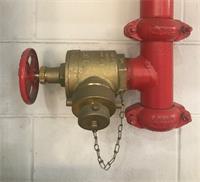What NFPA 14 Says About Hose Stream Allowance

Hose stream allowance or demand is the amount of additional water that is added to the sprinkler hydraulic calculation design, when hose connections are added to sprinkler systems. This allowance is not required for most hose connections installed as part of a combined sprinkler-standpipe system using NFPA 14 Standard for the Installation of Standpipe and Hose Systems, designed as a Class I, II or III standpipe system.
While sprinklers and standpipes can be supplied by a common riser in combined systems, the hydraulic system demands are done separately to the individual standard. NFPA 14 Section 7.10.1.3.1.1, includes hose stream demand in the sprinkler side of the calculation, but allows either the sprinkler plus hose demand or the standpipe demand to be used, whichever is greater. In most combined sprinkler-standpipe systems, the standpipe demand will always be greater.
The concept of providing an additional allowance for hose streams, used for firefighting, is not why we have hose stream allowances in fire sprinkler design. We have it to adjust the water supply needed for small hose connections that might be used for first aid and overhaul operations. The hose stream allowance just adds additional water to a “sprinkler only system” that has hose connections installed on that system.
Fire Sprinklers with Hose Connections
 Over the years, local jurisdictions have often required hose connections in buildings, equipped with only sprinkler systems, which did not have a requirement for a standpipe system. This creates a potential water supply issue. To address that concern, a hose stream allowance is added to the water supply calculation to make sure the fire sprinkler system has the appropriate amount of water to properly operate.
Over the years, local jurisdictions have often required hose connections in buildings, equipped with only sprinkler systems, which did not have a requirement for a standpipe system. This creates a potential water supply issue. To address that concern, a hose stream allowance is added to the water supply calculation to make sure the fire sprinkler system has the appropriate amount of water to properly operate.
It is imperative to ensure an adequate water flow is available for the sprinkler system to operate correctly when a hose connection is added on a sprinkler system and used simultaneously. It is equally important to understand that while NFPA 13 Standard for the Installation of Sprinkler Systems allows hose connections to be added, there is no substantial code requirement for this configuration.
NFPA 14 and the Fire Service
This use of hose connections on sprinkler systems has caused confusion in the fire service, not recognizing that, not all hose connections in a building are created equal. Some are hose connections on a sprinkler system with a hose stream allowance, while others are designed to NFPA 14, meeting the flow requirements for standpipe hose connections. Understand that hose stream allowance or adjustments do not meet the requirements for interior structural firefighting.
Even when designed to NFPA 14, not all standpipe hose connections meet the standard required flow for interior structural firefighting. Class I standpipes are designed for the purpose of providing the flow required. Class II standpipes are obsolete and only designed for trained fire brigades to contain fires in the incipient phase. Class II standpipes do not meet the requirement for flow need for interior structural firefighting.
There is no current model code requiring the installation of Class II standpipes. While Class III has both 1 ½ in. and 2 ½ in. hose connection, only the Class I portion meets the flows required. In most cases where Class III standpipes are required by the code, there are exceptions allowing for only the Class I portion to be installed.
Small Hose Connections
For many years, small hose connections were required in some storage configurations and stages. They are fairly antiquated in the modern code design world, but there remain some areas that may require water adjustments. Take a combined system in a building equipped with only partial automatic fire sprinkler protection.
This configuration would be required to meet the flow requirements of NFPA 14 Section 7.10.1, but shall also be increased by an amount equal to the hydraulically calculated sprinkler demand,150gpm for light hazard, or 500gpm for ordinary hazard occupancy, whichever is greater. While this is not specifically a hose stream demand allowance, it addresses the need for additional water supply in partially protected structures. Again, this is only applicable to a combine system designed to both NFPA 13 and NFPA 14 standards.
Stages
The other great holdouts are stages greater than 1,000 square feet that are fully protected throughout with an automatic fire sprinkler system. Small hose connections on the sprinkler system are allowed but would require a hose stream allowance. This is allowed to provide first aid protection and fire containment of the stage area. T
The code allows the use of an NFPA 14 designed Class III as a more reasonable alternative and in buildings without fire brigades trained to use that Class II portion of the standpipe, only the Class I portion is required. This would provide the fire service with a NFPA 14 Class I standpipe designed for the flow required for use in interior structural firefighting.
Have a Codes or Standards Question? Contact the NFSA Today!
NFSA members enjoy access to the association’s Expert of the Day service. This service answers any codes or standards questions relating to fire protection. Our experts cite the standard in question and provide answers in less than a business day!
For more information on membership with the National Fire Sprinkler Association, visit our membership page!
